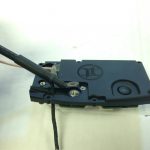This GPS dog collar system is typically used by hunters (among others) to follow their furry friends on the hunt. We have customized them to help us track the dye overnight, when boat, jet ski and airplane operations are suspended. Four drifters (smurf, snork, bugs, and daffy) will be deployed on the periphery of the dye plume before dark, and we will use the hand-held tracker to find them the next morning to direct resumption of our samples. Below are a few photos of the process.
- Coaxial cables used to extend VHF (black) and active GPS (white) antennas. The second wire coming from the black cable is the shielding, which was grounded on the device’s circuit board to minimize the change in transmission frequency caused by altering the antenna length.
- Here is the hand-held Astro 320 and the collar’s battery pack + brains. Notice the disconnected coaxial antenna cables, this allows us to separate the transmitter from the drifter for data dump (the collar stores its lat/lon history) and charging.
- The coaxial cables were fed through a stainless steel tube and spliced in to the manufacturer’s antennas. This photo shows them being removed from a mold, encased in epoxy. The orange piece is the GPS antenna and the black wire is the radio (VHF) antenna.
- Here Derek Grimes assembles the drifter bodies–notice the sweet pink antennas :D. The upper, white PVC houses the “collar” while the lower, gray PVC contains lead shot ballasting to keep the drifter upright.
- This is the completed drifter doing what it’s supposed to, drifting. The four vinyl sails help the drifter go with the flow, and the white buoys–well, they keep it afloat.





